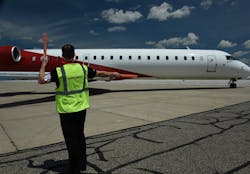On October 14 of this year, Delta Air Lines reported a third-quarter profit of $1.3 billion. The record breaking milestone was reported in the Atlanta-Journal Constitution by Russell Grantham.
Grantham reported in the very same article that Delta would cut an undisclosed number of jobs from the company’s “management and salaried” workforce over the next few months to “boost productivity.”
In the same week as Delta’s announcement, American Airlines, Southwest Airlines and Alaska Air Group all reported record quarterly profits. Even with considerably C-suite management turmoil, both United and Air India reported profit increases and a return to profit, respectively. And that was just in one week. Airline profits, as key indicators for industry-wide growth, are booming.
Why then, are airlines hedging their future projections?
Fuel prices.
"With volatile fuel prices and revenues under pressure," Paul Jacobson, Delta’s chief financial officer, said in an October statement. "We are using the current environment to evaluate and prune costs across all parts of the business, including our overhead functions, making sure we're investing in the right parts of the airline and at levels we can sustain over time.
Fair enough. Delta’s third-quarter revenue was, in fact, down one percent compared to 2014 and, according to Jacobson, the company’s fuel price fortune “will drive a $750 million benefit in the December quarter.”
To a tee, airlines across the country are warning that profit levels of this a nature are currently unsustainable due to fuel price volatility, but Airlines for America (A4A), a lobbying group for the airline industry, issued a similar statement last year as well.
“Declining fuel prices are good news for everyone as they lower personal costs and enable industries such as airlines that rely heavily on fuel to reinvest in their business and their customers,” the release, dated December 14, 2014, said.
And, in fact, A4A estimated in 2014 that airlines were reinvesting $1 billion per month back into operations – including GSE and other equipment purchases. That number has only grown with a year of profitability, according to A4A.
“Finally, U.S. airlines are growing once again,” Melanie Hinton, managing director for airline industry public relations and communications at A4A, says. “This has allowed airlines to reinvest in operations and equipment and on average $1.3 billion/month into the passenger experience offering enhanced inflight entertainment options on aircraft; adding bigger, newer planes to their fleets.”
What then, if profits are driving growth throughout the aviation industry and airlines insist that lower fuel prices are the key driver for their increased profits but those prices can’t be relied upon to continue the trend, is the industry supposed to do?
Don’t Be Crude
Fuel prices are normally the largest expense for airlines, and often in all of aviation. A4A says, after combining SEC filings for 10 of the United States’ busiest airlines, that wages and benefits (29 percent) have replaced fuel costs (24 percent) as the largest operating expenses for the airline industry.
The per gallon cost of fuel has dropped 37.1 percent in compared to prices in Q3 2014. Even with relatively flat revenues, that creates a massive amount of room to breathe for airlines. But that’s all fairly common knowledge. What happens next?
“The consensus amongst major oil industry associations—including the Organization of Petroleum Exporting Countries (OPEC) and the International Energy Agency (IEA)—is that crude oil will remain relatively low, below $80 per barrel, heading toward 2020 due to plentiful supply and falling demand across developing countries,” CR Sincock, managing director of business development at Avfuel, says.
“But also a weakening supply growth outside of OPEC resulting in a gradual rise in price. This is consistent with the U.S. Energy Information Administration’s projections that West Texas Intermediate crude oil prices for 2016 will slightly rise from this year’s $49.88 a barrel to $51.31. We would have to agree with the projection of these associations.”
So the oil industry is expecting per-barrel prices to rise, which is expected about as much as airlines trying to push profit projections down, except that rise is 2.9 percent in 2016. And that rate is projected through 2020.
Obviously that percentages mentioned in this section aren’t apples-to-apples. A4A is citing per-gallon prices for finished fuel whereas Avfuel’s numbers are per-barrel projections for crude oil. The comparison, however, reveals that fuel prices will not be jumping 37 percent anytime soon the way they have plummeted in the past year.
“Barring unforeseen events – such as hurricanes, earthquakes, floods and other natural disasters, as well as political climates – we think it’s very reasonable to say that while steadily increasing, overall, crude-oil prices will remain low, which customers should see reflected in the end price of jet fuel products,” Sincock says.
The Air Necessities
Maybe we’ve read too much into the pessimism of the airlines’ earnings reports. Perhaps they’re just looking to push down expectations on Wall Street so they can wow the analysts again in the fourth quarter. After all, this is still an industry in recovery.
“While the price of fuel has fallen year over year, fuel remains one of the airlines biggest and volatile expense,” Hinton says.
“This year is the first year since the Great Recession that U.S. airlines’ profitability has fallen in line with the average U.S. company,” Hinton says. “This return to profitability has benefitted customers as airlines are strong, able to compete and reinvest in their business with new planes, products and destinations, including expanded service to small communities and internationally, which in turn creates jobs.”
Airlines for America says that, finally, airlines are coming back into line with other business sectors around the country and that fuel prices are a big part of that. Surely that’s the case. But given the rate at which airlines are reinvesting in their operations, including GSE, it doesn’t appear that the airlines’ fuel-based profit projections are hindering them as a key indicator in aviation.
If there’s really anything to worry about for airline financials, it’s that revenue remains pretty flat with an increase in the number of passengers carried. The fact remains, however, that expenses have fallen so far for airlines that they’re able to provide fare decreases for customers and reinvest in employees and equipment.
“While lower crude prices do translate to lower fuel costs, it stems from flat demand and increased supply, which tends to be an indicator of an economy that’s slow to grow,” Sincock says.
The best conclusion to be drawn from what we know is that profits are going to remain high with oil prices rising just below 3 percent per year. Based on the rate that airlines have been putting that money back into operations and GSE purchasing, that’s good news for the entire industry.
Q3 Profits
The United States' Big Four airlines all saw profit increases in Q3 2015. Three of the four set new profit records.
American Airlines
$1.9 billion
United Airlines
$1.7 billion
Delta Air Lines
$1.3 billion
Southwest Airlines
$584 million
Pullquotes:
Airline profits, as key indicators for industry-wide growth, are booming.
Delta’s third-quarter revenue was, in fact, down one percent compared to 2014 and, according to Jacobson, the company’s fuel price fortune “will drive a $750 million benefit in the December quarter.”
Airlines across the country are warning that profit levels of this a nature are currently unsustainable due to fuel price volatility.
A4A estimated in 2014 that airlines were reinvesting $1 billion per month back into operations – including GSE and other equipment purchases. That number has only grown with a year of profitability.
The per gallon cost of fuel has dropped 37.1 percent in compared to prices in Q3 2014.

